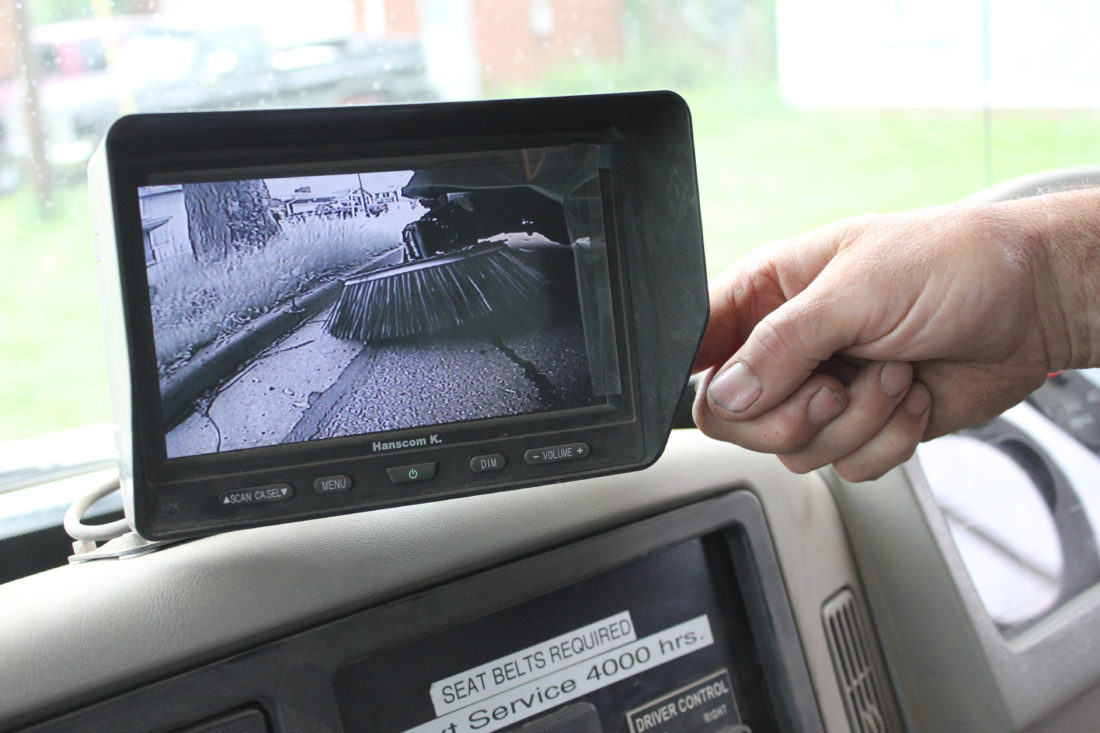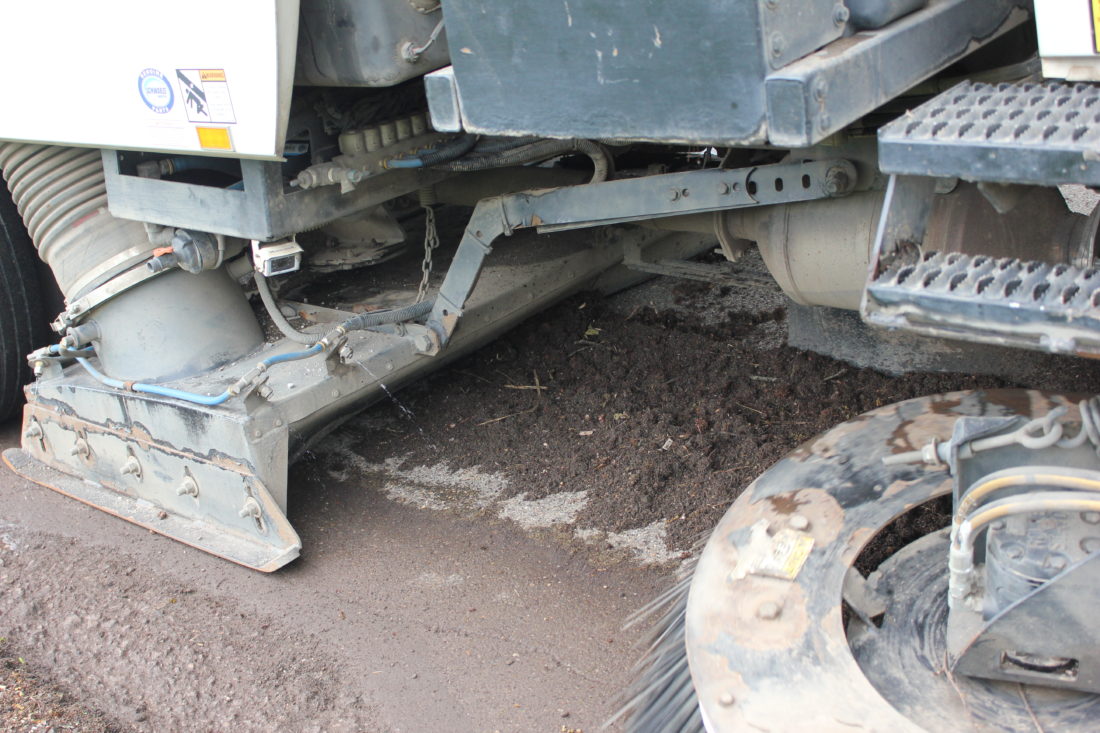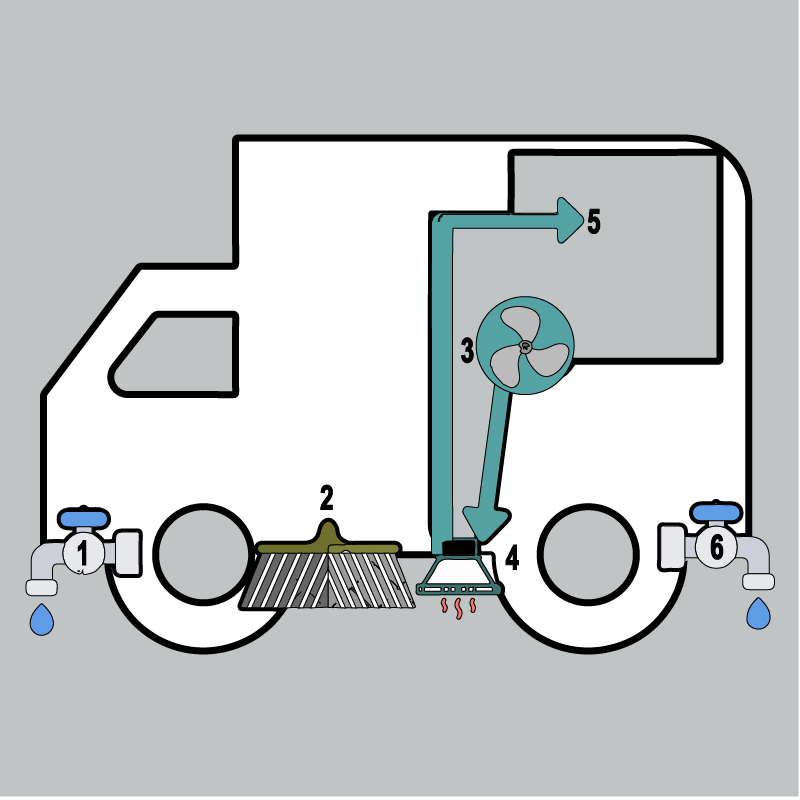How it works: Street sweeper combines water, brooms, vacuum

JANELLE PATTERSON The Marietta Times Marietta Street Foreman Chris Hess drives down Sheldon Avenue Wednesday, clearing gumballs from the road with the city street sweeper.
The first line of defense for motorists, cyclists and storm drains is a truck that drives back and forth along city streets.
“The main purpose is to keep the streets safe, pick up the nails, the loose gravel, glass, metal, dirt, sand, etc.,” explained Street Foreman Chris Hess about the street sweeper. “It picks up small debris to keep the roads clear and usable.”
And after a long winter, where roads accumulate the sand used in clearing snow, the sweeper is out daily on residential and main thoroughfares.
“In the spring at night the shift was picking up five to six loads a night and then the day shift was probably four or so,” said Todd Stockel, streets superintendent.
One load in the street sweeper is 8.4 cubic yards, or approximately three tons of debris, which get sucked up through the sweeper and dumped for disposal.

How it cleans
Inside the truck sit two engines. One powers the truck itself, propelling with diesel fuel the monstrosity down the streets of the city.
“That’s up in the front, it moves the whole truck,” Hess said as he pointed to the hood of the truck. He was sitting in the curbside seat, steering one of two wheels, hitting the gas and brakes that can be controlled from either side. “This separate panel (between the two cockpit seat) controls the engine in the back.”
The second engine exists solely to power the circular broom heads, water spouts and suction to pull the debris into the back hopper.
At the front of the vehicle sit the first round of spouts, which wet the road and debris.

“That’s to prevent dust,” explained Hess. “It allows the dirt and debris to be compacted down to then be better swept toward the head.”
Then behind the front wheels of the truck sit the two broom heads. Either can be operated singularly or in unison from both sides of the cockpit, though the driver will mostly sit on the righthand side of the vehicle and steer while watching the curbside broom.
“They spin towards the center, pushing the debris to the head,” added Hess.
And with rubber skirts keeping both the debris from getting shot under the truck and across the other side of the road, and creating a seal around the head, regenerative air is pumped through the back end of the vehicle, pulling the debris up into the hopper.
“There’s a fan that sits above the hopper which pushes air down one hose, then that air is pushed across the head and up another hose into the hopper with the debris,” Hess explained.

How the street sweeper cleans: 1. Sprays water on the ground to temper dust. 2. Pushes debris with oscillating broom heads toward the center skirt. 3. Uses air pressure forced from a fan to push the debris across the head. 4. Pulls that debris and air back up into the hopper. 5. Sprays water on the ground following behind to rinse the street. Source: Marietta Street Foreman Chris Hess.
Stockel pointed out that the rubber skirts allow for the force of that air to be maintained and controlled for optimum performance.
“But what catches is if sticks get stuck up in the hose as the debris is pulled into the hopper,” he said. “Or if leaves are pushed into the street, it clogs that machine.”
Hess also pointed out that grass clippings can clog the hose and make it difficult to sweep up gravel and gumballs dropped by trees.
“The sweeper is not a leaf machine, we have a separate machine designed to pick those up that can handle them,” said Hess. “This is used to keep the roads and drains clear. We even will use it to clean off a road before chip and seal.”
When the hopper is full, Hess said, the sweeper just stops sucking debris.
“That’s when the operator will drive it back to our equipment garage and dump the waste here that we then get hauled out of here,” summarized Stockel.
Challenges
While the service of cleared streets is a top priority of the streets department, the execution faces some literal roadblocks.
The first is getting the public to move their cars to the opposite side of the road when the sweeper is coming through.
Parked cars on city roads in the way of the curbside sweep not only leave gravel on the road but also can leave debris in the curbs and gutters that get washed into storm drains.
“That creates other problems in keeping up the storm drains which are there to protect from flooding,” said Hess.
Marietta City Council President Josh Schlicher noted that there is already public participation when the streets crew goes through town in the fall to pick up leaves,
“We need more public participation in moving their cars to get these streets cleared the rest of the year though,” said Schlicher. “It’s a service people want and I think is a priority but what works with leaves is awareness and a schedule.”
Stockel said one of the challenges in scheduling sweeping is volume.
“We hit so many more streets in a day with the sweeper that we would need more signs to do the same night-before signage to get people to move their cars,” he explained. “(Plus) fall and spring job loads are different because when we do leaves, we have two crews that solely focus on that for a few weeks, whereas with the sweeper it’s one guy in the day and one in the later shift, while the rest of us are trimming trees, mowing grass and taking care of other things.”
Stockel noted it takes two to three days to sweep Norwood, but almost two weeks to hit all of the numbered streets downtown and their corresponding side streets.
But Schlicher said this could be accomplished more efficiently with better awareness and enforcement of a schedule.
He acknowledged that in other cities residents can be ticketed if parked in the path of a street sweeper.
“But that would be in places where a clearly defined and adhered to schedule is in place so people know on certain days when they need to have their car on the other side of the road,” he said.
The city already has in place similar ordinances like the prohibition of parking on certain roads in snow storms, and Section 307.01 of the city’s codified ordinances gives city police the authority to remove and impound vehicles for interfering with street cleaning operations.
But that section is not enforced by MPD.
“Having a schedule could be part of the solution,” said Schlicher. “But it would have to be reliable and followed regardless of different department members’ vacation time and such. It’s a necessary and important service.”
That necessity is also what influenced Schlicher’s tie-breaking vote two weeks ago at council’s regular meeting.
At the May 3 meeting some members of council were not comfortable picking up the added expense of $186,517.52 from the capital improvements fund to replace the current sweeper with a newer model.
The six-figure cost was proposed as a savings of $67,500 if the city would trade in its existing street sweeper along with the purchase.
“We try to recycle the sweeper every five years because technology has improved and the trucks become more efficient,” said Hess.
“Plus we see a better buy-back price in that time before the sweeper is too worn out to be of value,” added Stockel. “This new one is that price because there are new (Environmental Protection Agency) engine requirements that need to be put into a sweeper.”
The new sweeper was authorized by council on May 3 with a 4-3 vote in favor of the purchase. The new sweeper will be delivered in a few months after it is finished being built.

